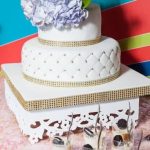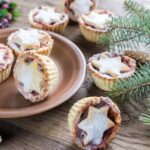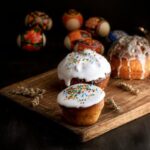Chocolate decoration cakes have become increasingly popular in the dessert industry, captivating both cake enthusiasts and professional bakers with their enticing aesthetics. The art of adorning cakes with chocolate accents has become a prominent trend, and cake decorators are continuously pushing the boundaries of creativity to elevate their designs. This article delves into the delectable world of chocolate decoration cake ideas, offering inspiration for both amateurs and experienced bakers alike.
One cannot underestimate the power of chocolate when it comes to enhancing the visual appeal of cakes. The velvety texture, rich colors, and tempting flavors make chocolate an ideal medium for artistic expression. Whether it is delicate swirls of melted dark chocolate or intricate lace-like patterns created from white chocolate, these beautifully crafted decorations can transform an ordinary cake into a mouthwatering work of art.
As the demand for unique cakes grows, so does the desire to incorporate innovative designs using different types of chocolate. Dark chocolate brings a rich intensity to cake decorations, while milk chocolate adds a creamy sweetness. White chocolate lends itself perfectly to delicate designs due to its smooth and malleable nature. With such versatility at hand, cake decorators have endless opportunities to experiment with various flavors and textures by combining different types of chocolates in their creations.
The art of decorating cakes with chocolate has evolved into a form that extends beyond borders and limitations. Cake artists are continually discovering new ways to use this versatile ingredient, creating intricate textures that captivate the eye. From luscious ganache drips cascading down a cake’s sides to elegantly curled shards that add dimension, these techniques provide depth and visual interest that make each cake truly unique.
In this article series, we will explore the endless possibilities that arise when one combines creativity with chocolate decoration cakes. From textured embellishments to painted masterpieces, sculpted figures, elegant collars and ribbons, all the way to dazzling garnishes, the world of chocolate decoration cakes holds something for bakers of all skill levels. So let your imagination run wild, and embark on a journey that will not only tantalize taste buds but also delight the eye with delectable designs.
The Versatility of Chocolate
Chocolate is not just a delicious treat, but also a versatile medium for cake decoration that allows for creativity to flourish. With its rich flavors and ability to be molded into various shapes and textures, chocolate has become a beloved choice for adding aesthetic appeal to cakes. Whether it’s dark, white, or milk chocolate, each variety offers its unique qualities that can take cake decoration to the next level.
One of the reasons why chocolate is so versatile in cake decoration is the diverse range of types available. Dark chocolate, with its intense flavor profile and higher cocoa content, pairs well with rich and bold cake flavors like red velvet or espresso.
On the other hand, white chocolate brings a creamy and sweet taste that complements fruity or light cakes such as lemon or strawberry. Milk chocolate strikes a balance between the two and adds a smooth and familiar taste to any cake creation.
Not only does chocolate offer different flavors, but it also has the flexibility to be shaped and molded into intricate designs. From delicate curls to elaborate ganache drips, there are endless possibilities when it comes to texture techniques using chocolate.
Creating textured decorations with chocolate can add depth and visual interest to cakes, making them stand out from the crowd. Whether you’re adorning your cake with elegant marbled patterns or delicate edible lace made from chocolate, these techniques allow you to showcase your craftsmanship and elevate your cake design skills.
Including an unordered HTML list in this paragraph:
- Dark Chocolate: Intense flavor profile, pairs well with rich and bold cakes (red velvet, espresso)
- White Chocolate: Creamy and sweet taste that complements fruity or light cakes (lemon, strawberry)
- Milk Chocolate: Balanced flavor profile that adds a smooth touch to any cake creation
Tempting Texture Techniques
One of the most exciting aspects of decorating cakes with chocolate is the opportunity to experiment with different texture techniques. These techniques not only add visual appeal to cakes but also enhance the taste and experience of enjoying a slice. Here are some step-by-step instructions on how you can create textured chocolate decorations for your cakes:
- Chocolate Curls: To create beautiful chocolate curls, start by melting a bar of high-quality chocolate. Once melted, spread a thin layer of the melted chocolate onto a baking sheet or marble slab. Allow it to cool slightly until it’s no longer runny, but still pliable.
Take a metal spatula and gently push it along the surface of the chocolate, creating curls as you go. Place the curls in the refrigerator to set before placing them on your cake. - Chocolate Shards: For dramatic and elegant cake decorations, consider using chocolate shards. Begin by melting your desired type of chocolate and spreading it evenly onto a sheet of parchment paper or acetate. While the chocolate is still warm and pliable, use a knife or bench scraper to create shards of different sizes and shapes. Let them set at room temperature or in the fridge until they harden completely before incorporating them into your cake design.
- Ganache Drips: Ganache drips add a luxurious touch to any cake design, giving it an eye-catching polished finish. Start by making your ganache by heating equal parts heavy cream and chopped chocolate until smooth and glossy. Allow it to cool slightly but still be pourable consistency before drizzling over the edges of your cake using a spoon or piping bag fitted with a small round tip.
These texture techniques can be used individually or combined in various ways to create unique designs that showcase both skill and creativity.
In addition to these techniques, marbled chocolate patterns and edible chocolate lace are other popular ways to embellish cakes with temptingly textured decorations. Marbled patterns involve swirling different shades or types of melted chocolate together before spreading it onto a sheet of parchment paper. Once cooled, the marbled chocolate can be broken into pieces and used as cake toppers, borders, or accents.
Edible chocolate lace is created by piping melted chocolate onto a lace pattern template and allowing it to set before carefully peeling it off. The delicate, intricate lace can then be added to cakes for an elegant and whimsical touch.
With these texture techniques in your repertoire, you can elevate your cake decorations with stunning chocolate designs that are sure to impress.
Unleashing your Inner Artist
Chocolate has long been cherished as a delicious treat, but its versatility extends far beyond simply satisfying our taste buds. In the world of cake decoration, chocolate has become a highly sought-after medium for artistic expression.
One captivating technique that allows bakers to unleash their inner artist is painting with chocolate. In this section, we will delve into the art of painting on cakes using melted chocolate as a medium, providing tips and techniques to achieve realistic and eye-catching chocolate brush strokes.
The Artistic Endeavor of Chocolate Painting
Painting with chocolate offers an exciting avenue for creativity in cake decorating. The rich colors and smooth texture of melted chocolate provide an ideal medium for creating intricate designs and personalizing cakes. Just like a canvas awaiting the artist’s brush strokes, a freshly frosted cake acts as the perfect backdrop for these edible works of art.
Techniques for Achieving Stunning Chocolate Brush Strokes
To achieve realistic and eye-catching chocolate brush strokes, it is important to follow certain techniques. First, it is essential to temper the chocolate properly to ensure it sets at the right consistency and maintains its shine. This can be done by melting high-quality chocolate until it reaches a specific temperature range and then carefully cooling it down while stirring constantly.
Once tempered, the melted chocolate can be transferred into piping bags or squeeze bottles for greater control during application. When painting with chocolate, it is helpful to use small brushes with soft bristles that allow for precise strokes. Start by outlining your design on the cake using fine lines of dark or colored chocolate before filling in larger areas.
Inspiring Examples of Painted Chocolate Cake Decorations
Painted chocolate cake decorations offer limitless possibilities for expressing your creativity. From delicate floral motifs to vibrant landscapes, there are endless ways to incorporate painted designs onto cakes. Imagine a garden-inspired cake adorned with hand-painted flowers or a whimsical birthday cake featuring a beautifully rendered scene.
To inspire your own artistic endeavors, here are some examples of stunning painted chocolate cake decorations:
- Floral Fantasy: Delicate hand-painted flowers in a variety of colors, seamlessly blending from one petal to the next.
- Artistic Landscapes: Intricate scenes depicting mountains, forests, or serene beaches brought to life with exquisite detail and texture.
- Geometric Elegance: Abstract patterns and designs created using precise brush strokes and contrasting chocolate colors.
Remember, practice makes perfect when it comes to painting with chocolate. Experiment with different techniques, color combinations, and subject matters to develop your unique style as an edible artist. The only limit is your imagination.
Whether you’re an experienced baker or a novice eager to try your hand at chocolate painting, this technique is sure to elevate your cake decorating skills and impress guests with your stunning creations. So grab that paintbrush and let the world of chocolate become your edible canvas.
Spectacular Sculpting
Exploring the Captivating World of Chocolate Sculpting and Modeling
In the fascinating realm of cake decoration, sculpting with chocolate opens up a realm of endless possibilities. Crafting chocolate figures and sculptures allows individuals to unleash their creativity and add an extra wow factor to their cake designs. From intricate flowers to adorable animals, the art of chocolate sculpting elevates cakes into edible works of art.
Tools and Materials for Creating Three-Dimensional Chocolate Cake Toppers
Before embarking on a chocolate sculpting adventure, it is essential to gather the necessary tools and materials. A set of high-quality modeling tools will be your best friend when shaping chocolate into different figures. These tools typically include various sized ball tools, knives, and spatulas, which help create smooth lines and textures.
To successfully work with chocolate in its solid form, having a heat source available is crucial. A heat gun or hairdryer can be used to gently warm the surface of the chocolate, making it more pliable for shaping and modeling. Additionally, having a parchment paper or non-stick mat on hand provides a perfect surface for working with chocolate without causing damage or sticking.
It’s important to note that not all types of chocolate are suitable for sculpting purposes. Look for high-quality melting or molding chocolate specifically designed for artistic use as these chocolates have a higher cocoa butter content which enables easy shaping and setting.
Achieving Simple Chocolate Sculptures: Tutorial-Style Instructions
For beginners looking to dip their toes into the world of chocolate sculpture, starting with simple shapes is recommended. Hearts, flowers, animals like butterflies or ladybugs can be easily crafted using basic techniques.
To begin creating a simple heart-shaped sculpture:
- Melt your chosen type of molding chocolate following package instructions.
- Pour the melted chocolate into a heart-shaped mold.
- Allow the molded chocolate to set in the refrigerator until firm.
- Gently remove the chocolate heart from the mold.
- If desired, use modeling tools to add texture or details to the chocolate heart.
- Place the chocolate heart as a topper on your cake or position it alongside other decorations.
Remember, practice makes perfect when it comes to sculpting with chocolate. With time and experience, individuals can progress to more complex figures and sculptures, elevating their cake decoration skills to new heights.
By incorporating the art of chocolate sculpting into their cake designs, bakers and decorators have yet another tool at their disposal to create show-stopping masterpieces that delight both the eyes and taste buds of those fortunate enough to enjoy them.
Whimsical Wraps
When it comes to creating a visually appealing cake, the presentation is just as important as the taste. One popular technique that adds elegance and sophistication to cake designs is using chocolate collars and ribbons to wrap around the cake.
Chocolate collars are a smooth, seamless band of chocolate that hugs the edges of the cake, while chocolate ribbons can be used to create decorative elements on top of the cake. In this section, we will explore the concept of using chocolate collars and ribbons in cake decoration, provide guidance on how to create them, and showcase innovative ideas for incorporating them into your designs.
To create a flawless chocolate collar that perfectly fits your cake, it is important to use tempered chocolate – this ensures that the collar retains its shape and doesn’t melt easily. Here’s a step-by-step guide on creating smooth and seamless chocolate collars:
- Melt your choice of chocolate (dark, white or milk) in a microwave or over a double boiler until smooth.
- Pour the melted chocolate onto a sheet of acetate or parchment paper.
- Use an offset spatula to spread the chocolate into a thin, even layer with straight edges.
- Once the chocolate has slightly cooled but is still pliable, carefully measure and cut it into strips wide enough to wrap around your cake.
- Gently lift each strip of chocolate and wrap it around the sides of your cake while ensuring there are no gaps or wrinkles.
- Smooth out any imperfections by gently running your finger along the edge.
In addition to using chocolate collars, you can also incorporate chocolate ribbons as decorative elements on top of your cakes. These ribbons can be created by piping melted tempered chocolates onto wax paper in intricate patterns or shapes.
Here are some unique ideas for incorporating chocolate ribbons:
- Create bows from thick, piped chocolate ribbons and place them at the top of a tiered cake for a classic and elegant look.
- Wrap thin chocolate ribbons around the base of each cake tier to create a layered effect that adds depth to your design.
- Use chocolate ribbons to create delicate flowers or leaves to adorn your cake.
By incorporating these whimsical wraps into your cake designs, you can elevate the visual appeal of your creations and impress your guests. The versatility of chocolate as a decoration medium allows for endless creativity in designing cakes that are not only delicious but also visually stunning. Experiment with different patterns, colors, and techniques to discover unique ways to use chocolate collars and ribbons in your cake decorations.
Dazzling Decorative Elements
Chocolate garnishes are the perfect finishing touch to elevate the aesthetic appeal of cakes. These decorative elements not only add a burst of flavor but also create visual interest and texture. From chocolate curls to filigrees and shavings, there are numerous ways to incorporate chocolate garnishes into cake designs.
One popular type of chocolate garnish is the chocolate curl. These delicate, spiral-shaped decorations can be made by gently scraping a knife against a block of chilled chocolate. The resulting curls can be used to adorn the top of cakes or placed along the sides for a stunning cascading effect.
Chocolate filigrees, on the other hand, are intricate designs that add an elegant touch to cakes. These delicate lace-like ornaments can be made by piping melted chocolate onto parchment paper in various patterns and allowing them to harden before carefully peeling them off.
Another way to use chocolate as a decorative element is by creating textured borders on cakes. This can be done by melting chocolate and using a piping bag or squeeze bottle to apply it in different patterns or shapes along the edges of the cake. The hardened chocolate creates a visually appealing border that adds dimension and sophistication to the overall design.
Incorporating these stunning chocolate garnishes into cake designs offers endless opportunities for creativity. Whether it’s cascading curls, intricate filigrees, or textured borders, these decorative elements enhance the beauty of any cake and add a touch of indulgence that will delight both eye and palate.
| Decorative Element | Description |
|---|---|
| Chocolate Curls | Spiral-shaped decorations made from scraped chilled chocolate |
| Chocolate Filigrees | Intricate lace-like ornaments made by piping melted chocolate onto parchment paper |
| Textured Borders | Melted chocolate applied in different patterns or shapes along the edges of the cake |
Inspiration at Your Fingertips
In conclusion, the world of chocolate decoration cakes offers a tantalizing array of possibilities for cake enthusiasts and professionals alike. The versatility of chocolate as a canvas for creativity allows for endless exploration and experimentation in cake design. From creating textured decorations with chocolate curls and ganache drips to painting intricate motifs using melted chocolate, there are no limits to what can be achieved.
One of the most exciting aspects of working with chocolate in cake decoration is the ability to sculpt and mold it into three-dimensional figures and sculptures. With the right tools and materials, beginners can create simple yet impressive chocolate sculptures such as hearts, flowers, and animals. It’s an opportunity to unleash your inner artist and bring your cake designs to life in ways that will surely impress your guests.
But it’s not just about sculpting or painting with chocolate; wrapping cakes with chocolate collars and ribbons adds an elegant touch to any design. Learning how to create smooth and seamless chocolate collars that perfectly hug the edges of a cake can take your creations to new heights. And don’t forget about the finishing touches – incorporating different types of chocolate garnishes like curls, filigrees, and shavings can add that extra dazzle to your cake decorations.
To help you find inspiration for your own chocolate decoration cake ideas, we have curated a collection of stunning examples from various themes, styles, and colors. The high-quality images accompanied by detailed descriptions will ignite your imagination and get those creative juices flowing. Additionally, we have provided links to additional resources and tutorials so you can delve even deeper into the world of chocolate decoration cakes.
Whether you’re a professional baker or someone who simply enjoys creating beautiful desserts, exploring the world of chocolate decoration cakes is sure to satisfy your sweet tooth for both taste and visual appeal. So go ahead, indulge in this deliciously artistic endeavor, let your imagination run wild, and create stunning edible masterpieces that will leave everyone wanting more.
Frequently Asked Questions
What to put on chocolate cake for decoration?
When it comes to decorating a chocolate cake, you have a variety of options to choose from. One classic and simple decoration is powdered sugar or cocoa powder sifted on top of the cake for an elegant and understated look. Another popular choice is chocolate ganache, which gives a glossy and luxurious finish to the cake.
You can also consider using chocolate shavings or curls made from milk, dark, or white chocolate to create texture and visual interest. Additionally, fresh fruits like berries or edible flowers can be artfully placed on top of the cake for a pop of color and natural appeal.
How to easily decorate a chocolate cake?
Decorating a chocolate cake can be made easy with a few tricks and techniques. Firstly, using a piping bag fitted with a star tip, you can create beautiful borders or piped designs along the edges of the cake. This adds an instant touch of elegance without much effort.
Secondly, utilizing stencils can help you achieve clean and precise patterns on top of the cake with powdered sugar or cocoa powder. Simply lay the stencil over the cake and sprinkle your chosen ingredient through it for eye-catching results. Lastly, incorporating pre-made decorations such as edible sprinkles or small chocolate candies can be an effortless way to add charm and personality to your chocolate cake.
What is the best chocolate to decorate a cake with?
Choosing the best type of chocolate to decorate a cake primarily depends on personal preference and intended taste profile. However, darker chocolates tend to work well as they provide depth and intensity in both flavor and appearance. Semi-sweet or bittersweet chocolates are commonly favored for their rich cocoa taste without being overly sweet.
These chocolates also hold up better when melted down for ganache or as coatings for truffles, allowing them to retain their shape while providing a smooth finish on cakes. Nonetheless, feel free to experiment with different varieties such as milk chocolate or white chocolate if you desire contrasting flavors or lighter aesthetics in your decorated chocolate cake.

Welcome to my blog about home and family. This blog is a place where I will share my thoughts, ideas, and experiences related to these important topics. I am a stay-at-home mom with two young children. I hope you enjoy reading it! and may find some helpful tips and ideas that will make your home and family life even better!





